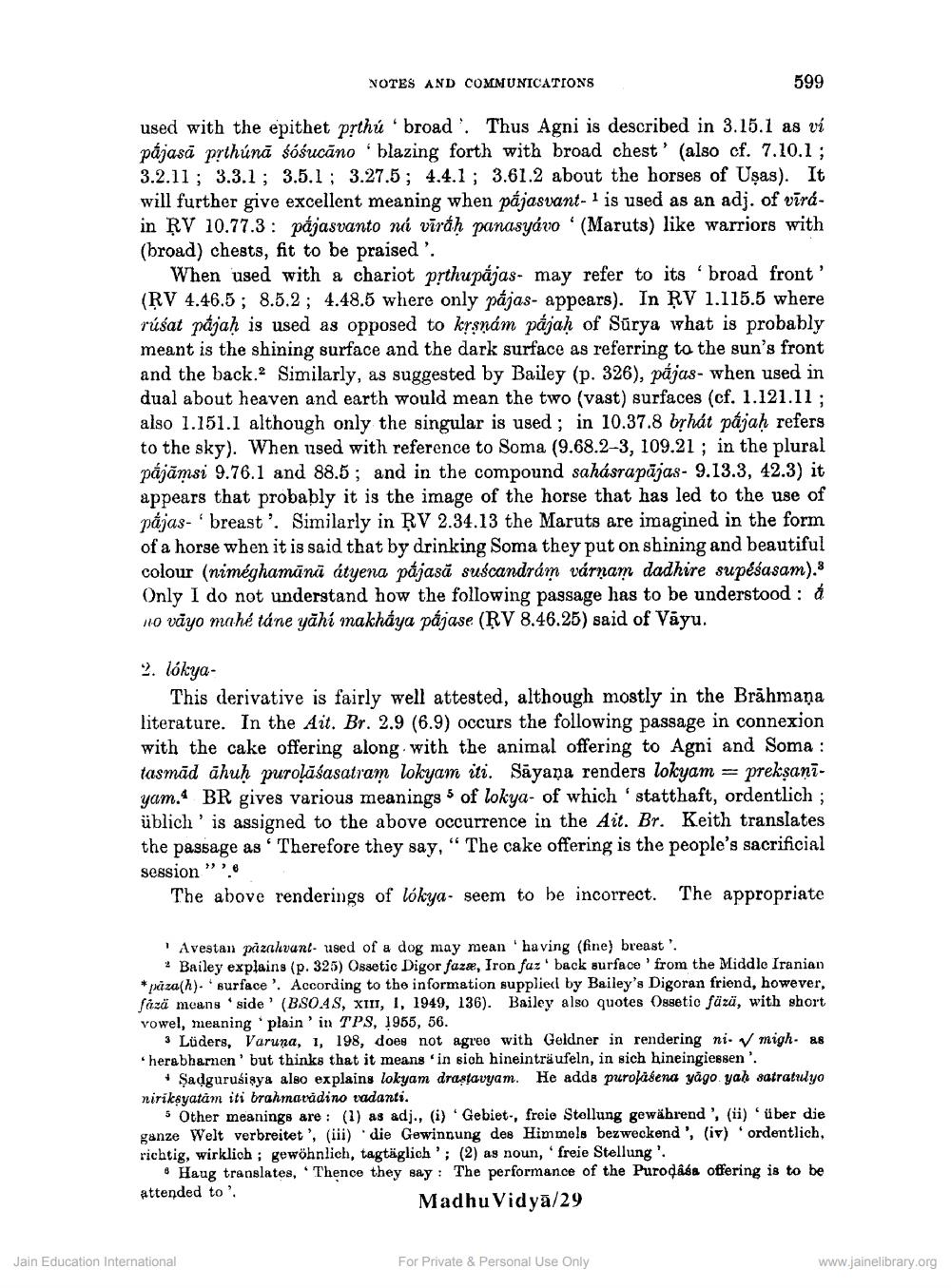________________
NOTES AND COMMUNICATIONS
599
used with the epithet prthú 'broad'. Thus Agni is described in 3.15.1 as vi pájasă prthúnā sósucāno blazing forth with broad chest' (also cf. 7.10.1; 3.2.11 ; 3.3.1 ; 3.5.1 ; 3.27.5; 4.4.1 ; 3.61.2 about the horses of Uşas). It will further give excellent meaning when pájasvant-1 is used as an adj. of vīráin RV 10.77.3: pájasvanto no vīráh panasyávo (Maruts) like warriors with (broad) chests, fit to be praised'.
When used with a chariot prthupájas- may refer to its 'broad front' (RV 4.46.5 ; 8.5.2; 4.48.5 where only pájas- appears). In RV 1.115.5 where rúśat pájaḥ is used as opposed to krsnám pájaḥ of Súrya what is probably meant is the shining surface and the dark surface as referring to the sun's front and the back. Similarly, as suggested by Bailey (p. 326), pájas- when used in dual about heaven and earth would mean the two (vast) surfaces (cf. 1.121.11; also 1.151.1 although only the singular is used ; in 10.37.8 bphát pájaḥ refers to the sky). When used with reference to Soma (9.68.2-3, 109.21 ; in the plural pájāmsi 9.76.1 and 88.5; and in the compound sahásrapājas- 9.13.3, 42.3) it appears that probably it is the image of the horse that has led to the use of pájas- ' breast'. Similarly in RV 2.34.13 the Maruts are imagined in the form of a horse when it is said that by drinking Soma they put on shining and beautiful colour (niméghamänä átyena pájasă suscandrám várnam dadhire supéśasam). Only I do not understand how the following passage has to be understood : a No vāyo mahé táne yāhi makháya pájase (RV 8.46.25) said of Väyu.
2. lókya
This derivative is fairly well attested, although mostly in the Brāhmaņa literature. In the Ait. Br. 2.9 (6.9) occurs the following passage in connexion with the cake offering along with the animal offering to Agni and Soma : tasmād āhuh puroļāśasatram lokyam iti. Sāyaṇa renders lokyam = prekşaniyam. BR gives various meanings of lokya- of which statthaft, ordentlich; üblich' is assigned to the above occurrence in the Ait. Br. Keith translates the passage as Therefore they say, “The cake offering is the people's sacrificial session »
The above renderings of lókya- seem to be incorrect. The appropriate
Avestan påzahvant- used of a dog may mean 'having (fine) breast'.
Bailey explains (p. 325) Ossetic Digor fazæ, Iron faz' back surface ' from the Middle Iranian *paza(h). Burface'. According to the information suppliecl by Bailey's Digoran friend, however, fázä means side' (BS0.4S, XIII, I, 1949, 136). Bailey also quotes Ossetio füzü, with short vowel, meaning plain' in TPS, 1955, 56.
Lüders, Varuna, 1, 198, does not agree with Geldner in rendering ni. ✓ migh. 88 herabhamnen' but thinks that it means 'in sich hineinträufeln, in sich hineingiessen'.
+ Sadgurušiaya also explains lokyam drastavyam. He adds purolasena yago yah satratulyo nirikayatam iti brahmavadino vadanti.
5 Other meanings are: (1) as adj., (i) 'Gebiet., freie Stellung gewährend ', (ii) über die ganze Welt verbreitet', (iii) die Gewinnung des Himmels bezweckend', (iv) ordentlich, richtig, wirklich ; gewöhnlich, tagtäglich '; (2) as noun, freie Stellung!
Haug translates, Thence they say: The performance of the Purodåss offering is to be attended to
Madhu Vidyā/29
Jain Education International
For Private & Personal Use Only
www.jainelibrary.org




